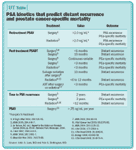Article
Using PSA kinetics to stratify risk of prostate cancer progression
Despite ongoing debate over the reliability of PSA as a marker of disease progression, it remains the primary means of determining prostate cancer recurrence following local therapy as well as the establishment of androgen independence following androgen deprivation therapy (ADT). This article provides an up-to-date review on the role of PSA kinetics—PSA velocity (PSAV), PSA doubling time (PSADT), and time to PSA recurrence—in evaluation and treatment of patients with prostate cancer.

One of the most controversial aspects of PSA monitoring is that it has created a new clinical state that includes men who have been treated with curative intent for localized disease and in whom the sole manifestation of disease is a rising PSA, indicating treatment failure. Based on the number of men diagnosed with prostate cancer who undergo radical prostatectomy (RP) or radiation therapy (RT) and the estimated probabilities of relapse, close to 50,000 U.S. men per year fall into this clinical state. Identification of the site of recurrent disease is important to direct appropriate salvage therapies or consideration for entry onto a clinical trial.

The PSAV, or rate of rise in PSA concentration, assesses changes in PSA over time. It was introduced to improve the effectiveness of serial PSA measurements for more efficient prostate cancer detection. PSAV is described by the formula: PSA2 – PSA1/time1 in years + PSA3 – PSA2/time2 in years
These three measurements should be obtained in a 2-year period or at least 12 to 18 months apart. A PSAV ≥.75 ng/mL per year has been described to suggest the presence of prostate cancer. A higher preoperative PSAV in the year before the diagnosis of prostate cancer has been shown to predict worse outcomes and a significantly higher risk for death from the disease following RP or RT.





